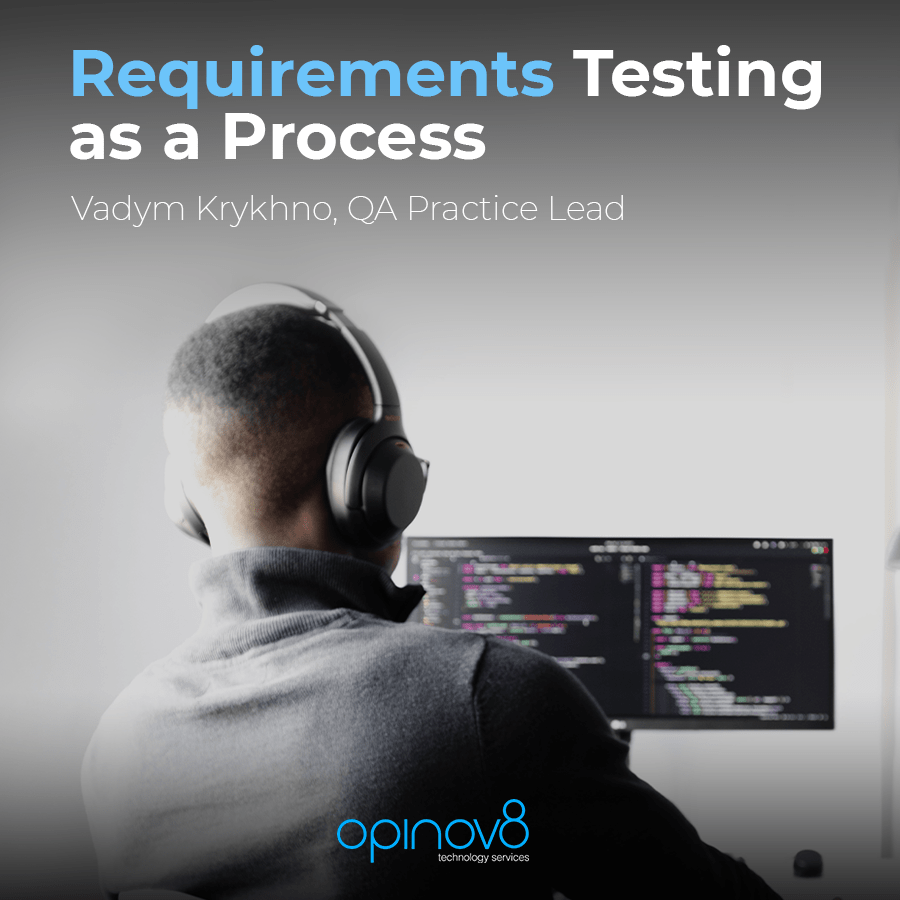
Opinov8 is a fast-growing company, and we, Opino8rs, are proud of it! We are always thinking about our future, our growth, and our customers — how could we provide the best service? Obviously, to achieve these goals, we must build strong and scalable processes. Requirements testing is one of them.
Today, we are going to talk with Vadym, Opinov8 QA Practice Lead. Vadym will tell us about one of the processes implemented in Opinov8 — requirements testing. This is a basic and mandatory process for all our projects.

As you know, requirements are the foundation for any development project. Projects start with documentation (requirements) and end with it. One of the most vital processes for us is requirements testing. In Opinov8 (for a project with SDLC based on Scrum), we created a few rules when implemented this approach:
We need to test the requirements exactly before these requirements are added to the sprint backlog. On the other hand, it is not necessary to perform these actions at a very early stage because there is a possibility that these requirements will lose their relevance.
As a result, we can significantly reduce the cost of the project (or sprint, since we are talking about testing requirements as a sprint activity).
Our Business Analysts use a requirements approach based on the INVEST mnemonics described here. However, from the QA practice side, when we do Requirements Testing, we also stick to the following aspects:
All statements must be correct, truthful, and make sense. Testing a system for incorrect requirements is a waste of time, money, and effort. How correct is your requirement? Is this really what is required of the system?
Can be traced back to the business problem or business need that triggers it. Does this really cover the needs of the business?
The requirement should contain all the information needed by the developers and everyone else who uses it to do their job. The requirement must include all the details necessary to express the needs of the users.
Requirements must not conflict with other requirements. Are all buttons or error messages in the same style?
There must be a way to check if the implementation meets the requirements. Can the requirements be verified? How do you do this, and what data and tools do you need?
Is it possible to develop the described functions, we do not have blockers and restrictions?
Anyone who reads the requirement must come to a common interpretation.
Is the requirement unambiguously defined so that it can be unambiguously referred to?
Are all scenarios covered in the requirements?
Requirements testing is a top priority to help you get your developing project to a really good level. Timely use of these activities can save the development team time and money.
Be curious and driven to explore new horizons and technology areas with us. Let's innov8 together!
#bebold #behuman
Opinov8 announces its new recognition as an Amazon RDS Delivery Partner. This accreditation underscores our expertise in managing and optimizing relational databases using Amazon RDS (Relational Database Service). We work with various engines like Amazon Aurora MySQL, Amazon Aurora PostgreSQL, PostgreSQL, MySQL, MariaDB, and SQL Server. This recognition shows our ability to help clients set […]
Opinov8 announces its new recognition as an Amazon RDS Delivery Partner. This accreditation underscores our expertise in managing and optimizing relational databases using Amazon RDS (Relational Database Service). We work with various engines like Amazon Aurora MySQL, Amazon Aurora PostgreSQL, PostgreSQL, MySQL, MariaDB, and SQL Server. This recognition shows our ability to help clients set […]
Implementing and managing Kubernetes on Google Cloud, AWS, and Azure can be complex and challenging without the right expertise. This is where Opinov8, a leading provider of Kubernetes professional services, comes into play.
Implementing and managing Kubernetes on Google Cloud, AWS, and Azure can be complex and challenging without the right expertise. This is where Opinov8, a leading provider of Kubernetes professional services, comes into play.